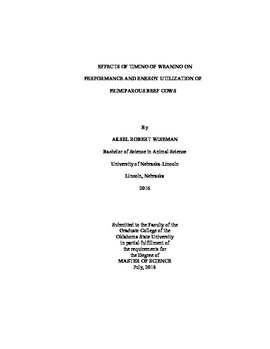| dc.description.abstract | Early weaning is used to minimize cow nutrient requirements in situations where feed inputs are scarce or expensive. For many years, maintenance energy requirements have been assumed to be 20% greater in lactating compared to non-lactating beef cows. Consequently, early weaning primiparous cow/calf pairs should improve overall efficiency, particularly in situations where mid- to late-lactation forage or feed nutritive value is low. The objective of this study was to determine the biological efficiency of early weaning and maintenance energy requirements of lactating versus non-lactating primiparous dams. Experiments were conducted in two consecutive years using 90 primiparous heifers and their calves (48 in yr 1, 42 in yr 2). Pairs were randomly assigned to one of 6 pens (8 pairs/pen yr 1, 7 pairs/pen yr 2) and pens were randomly assigned to each treatment; early weaning (EW, 130 d ± 15.4) and traditional weaning (TW, 226 d ± 13.1). Late-lactation cow and calf performance and feed consumption was measured for 92 d (yr 1) and 100 d (yr 2). Cows were limit-fed to meet maintenance requirements, while calves were offered ad libitum access to the same diet in a creep feeding area. Calves were not allowed access to the cows' feed. Cow feed intake, body condition score, body weight, milk yield and composition, and calf body weight gain and creep feed intake were recorded. After accounting for lactation and retained energy, there was a trend for higher maintenance energy requirements of lactating primiparous beef cows (P=0.07). From early weaning to traditional weaning, calf ADG (P<0.01) was significantly greater for TW calves. Feed and energy efficiency of the pair was improved for the TW system (P<0.01). Higher ADG was reported for EW calves during the stocker period (P=0.03), but there were no differences during the finishing period (P>0.40). During finishing, BW was higher (P=0.02) and G:F tended (P=0.06) to be higher for TW calves. The increased TW calf performance offset the additional maintenance costs of their lactating dams, allowing the TW system to be more efficient at converting total feed energy to kg of calf body weight gain. | |
